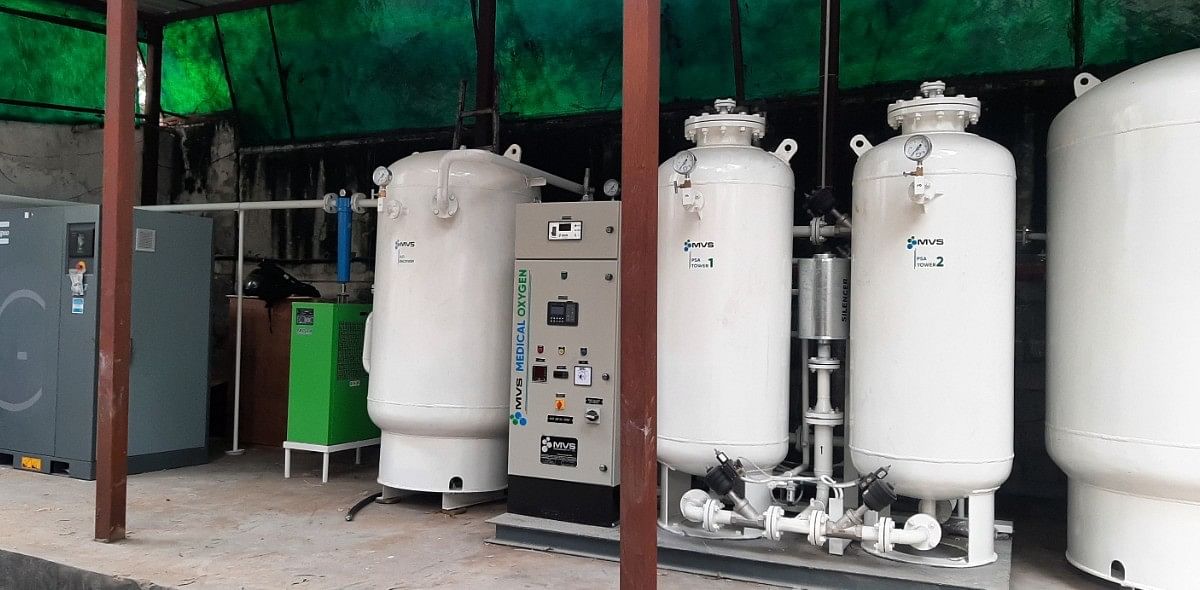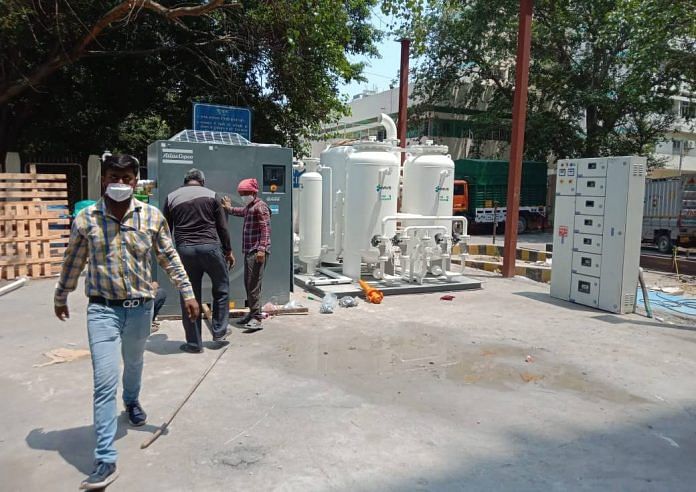New Delhi: Several hospitals in Delhi have started installing Pressure Swing Adsorption (PSA) Medical Oxygen Generation Plants in their premises as the fear of third Covid wave looms large.
A PSA oxygen plant employs a technology that absorbs nitrogen from ambient air to concentrate oxygen for supply to hospitals or the industry. The plant comes in varying capacities to generate oxygen.
Batra hospital in Tughlakabad Institutional Area in south Delhi, which faced an oxygen crisis during the second wave, Wednesday set up its first PSA plant which can generate 500 litres of oxygen per minute.
Currently, the 500-bed Batra hospital has two cryogenic containers or liquid oxygen storage tanks — 16 kilolitre and 6 kilolitre.
In May this year, 12 patients, including a doctor, died at the hospital due to oxygen shortage.

Besides Batra Hospital, government hospitals in the national capital have also installed oxygen generation plants and increased storage capacity as the city readies to tackle the next wave. However, doctors say these plants are “Option B” for hospitals as they stress the importance of liquid medical oxygen (LMO) facilities.
PSA plants at other Delhi hospitals
Lok Nayak Jaiprakash Narayan (LNJP) Hospital, the largest Covid facility in the national capital, has five PSA plants, which collectively generate 5 metric tonnes of oxygen per day. Apart from this, the hospital has also increased its LMO storage capacity to 50 metric tonnes from 30 metric tonnes.
“During the second wave, we could acquire 30 metric tonnes of LMO per day but now we have the capacity to transport and store 50 metric tonnes of LMO per day as we have added two more storage tanks now,” Dr Suresh Kumar, Medical Director of LNJP Hospital, told ThePrint.
Asked if it’s sufficient, he said, “55 tonnes of oxygen per day is enough for 2,500 beds in our hospital, but neither us nor any other hospital can say if it’s enough to cater to all patients since how long our oxygen will last depends on the severity (high flow or low flow requirement) of the patients admitted”.
Out of the 2,500 beds, 500 ICU beds are at the makeshift Covid hospital at Ram Leela Maidan, while 400 other ICU beds and 1,600 oxygen beds are at the LNJP hospital.
Similarly, Rajiv Gandhi Super Specialty Hospital, the dedicated Covid hospital in east Delhi, also has five PSA plants, which were installed by the Delhi government in June.
“Three of these plants produce 500 litres of oxygen per minute while the other two have the capacity to produce 1,000 litres of oxygen per minute. The hospital currently has one 10 kilolitre LMO tank and is in process of getting a 20 kilolitre LMO tank in the coming weeks”, Dr B.L. Sherwal, director, Rajiv Gandhi Super Specialty Hospital, told ThePrint.
“We have also increased the stock of our backup oxygen cylinders. All these combined together suffice the requirement of 650 oxygen beds in our hospital,” Sherwal said.
Meanwhile, Guru Teg Bahadur (GTB) Hospital has four PSA plants, which collectively have oxygen generating capacity of 2,000 litres per in a day.
“The NHAI had promised to donate two PSA plants having the capacity to generate 1,000 liter per minute oxygen flow each but we have only received one so far, which was unveiled 3 days ago. We are in conversation with them about the installation of the second one,” a senior doctor at GTB Hospital told ThePrint.
The doctor said these plants provide sufficient oxygen for 1,300 beds in the hospital, out of which 500 are ICU-HDU (High Dependency Unit) beds.
Deen Dayal Upadhyay Hospital also has one PSA oxygen plant, which has the capacity to generate 35 NM3 per hour of medical oxygen, an equivalent to 5 jumbo cylinders per hour, to ensure a dedicated oxygen supply for up to 115 beds, said Siddharth Rastogi, VP, Sales & Marketing, MVS Engineering Pvt Ltd, the company which installed the onsite oxygen generation plant.
Also read: How Covid ‘downsized’ India’s influenza problem & why experts say it’s not good news yet
Doctors stress access to LMO facilities
Even as states commission setting up PSA plants in hospitals, several doctors and medical experts say that while having an in-house oxygen generation plant is the need of the hour, they merely act as an “inverter” or “generator” in the time of crisis.
Instead, most of them stressed the need to ensure smooth access to the Liquid Medical Oxygen (LMO) facilities in neighbouring states such as Haryana and Uttar Pradesh to prevent the next oxygen shortage crisis.
“The government should look into ensuring smooth transportation of LMO across borders and provide more storage tanks to hospitals to prevent the oxygen shortage we suffered during the second wave,” said Dr Pavan Gurha, Head of the Department of Anaesthesiology & Critical Care at Batra hospital, speaking to ThePrint about the measures that need to be taken ahead of a potential third wave.
“Although we are better prepared this time, it is not viable for us to produce sufficient in-house medical oxygen with these PSA plants, we have to rely on liquid medical oxygen facilities in Haryana and Uttar Pradesh,” he added.
“We never faced a shortage of LMO ever. But during the Covid peak, our oxygen consumption went up seven times, and moving LMOs across borders became a major challenge, resulting in an oxygen crisis in Delhi”, he said.
The senior doctor at GTB Hospital quoted above explained how most hospitals are concerned over timely delivery of LMO from manufacturing plants located in other states.
“The major reason why Delhi was hit by the unprecedented oxygen crisis during the last wave is that the oxygen supply stopped or was deliberately cut by the plants located in Uttar Pradesh and Rajasthan. We need to make sure the supply chain is maintained at any cost if a third wave strikes Delhi again in the coming months,” he said.
At LNJP, Dr Kumar said: “Eighty per cent of our oxygen demand is met through LMOs, PSA plants are option B.”
(Edited by Neha Mahajan)
Also read: In India’s vaccination race, Covishield at 88% beats Covaxin hands down



